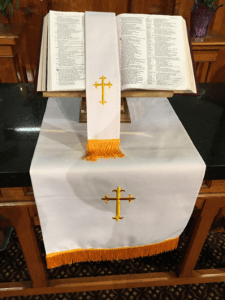What’s Color Got to Do With It?
What’s Color Got to Do With It?
by Bill Handy
 Ever noticed the color of the clothes draped across the Bible and the Communion Table? Why do they change over the year? How do people know when to change them (assuming people do and not the church mice)?
Ever noticed the color of the clothes draped across the Bible and the Communion Table? Why do they change over the year? How do people know when to change them (assuming people do and not the church mice)?
It all has to do with ancient times in the church and the lack of written/printed calendars. When you had a church people who were mainly illiterate and when paper and printing didn’t exist or were in very short supply, you used other means to “tell time.” The seasons of the year help: in our northern clime, we have definite seasons of spring, summer, fall and winter to help set the cycle of the year. Observant folk might have used the cycles of the moon and the movement of the sun on the horizon as a way to mark time (think Stonehenge). Other cultures observed the movement of the stars on the horizon and across the skies to note the seasons.
Well, the Church decided to mark time with colors placed on prominent pieces of worship furniture to help people understand where they were in the seasons AND, more importantly, what the season of the church year they were in. In a church year with multitudes of feast days for saints, rites and observances, and recurring events like Easter, Christmas and Pentecost, how were you supposed to keep it all in order?!
Besides, the Church and the secular forces of various times were often at odds about power and control. Use of color in worship may have been another way of the Church to assert its control over society in addition to providing order for its own functions.
So-o-o, color on paraments (pieces of cloth draped or arranged on worship furniture such as pulpits, communion tables, altars, etc.) became one of the ways to help narrate the church year. It was simple: look at the front of the church and note the colors. It could tell you what season the church year you were in.
The church year varies from the secular year. For instance, have you ever noticed how the date of Easter seems to jump all over the calendar from mid March to late April? You would think that such an important date would be fixed and easy to anticipate, like Christmas Day always being December 25th. But because the Jewish great feast day of Passover is so integral to the story of Easter, the date has to vary. And since the Jewish calendar is lunar based, dates are not the same year-to-year. With a lunar month being about 28 days or so, it doesn’t fit into a solar calendar neatly.
Thus Easter is calculated this way: Easter is the first Sunday after the first full moon after the spring equinox. If you can’t remember that, you could simply look at the front of the church and see when the white paraments appear in spring.
This is a roundabout way of getting to why the church mice change the colors at the front of the church. Each “season” of the church year has its own color. Those seasons are Advent, Christmas, Epiphany (or after Christmas), Lent, Easter, Pentecost (one day), and the season after Pentecost (basically all summer, fall and early winter). The colors used in the church year are: VIOLET or PURPLE (perhaps BLUE), WHITE, BLACK, RED, and GREEN. Each “season” has a color assigned to it for clarity. Though sometimes the same color is used for two seasons. Bear with me; it will come clear once the fog lifts.
The church year begins with Advent, not January 1st. So four Sundays before Christmas Day, the church mice change the colors at the front of the church to, ta-da, VIOLET or PURPLE. (Just to muddy the waters a bit, in the last 30 years or so folks have been advocating and using the color BLUE for Advent to make it distinct from Lent which uses VIOLET as well.) Both VIOLET and BLUE are colors associated with royalty so they fit well into the intent to honor the approaching birth of Jesus.
On Christmas Eve, the color changes to WHITE, representing purity. This color remains at the front of the church through Epiphany Day and the Baptism-of-Christ Sunday, which is the Sunday after Epiphany Day, which is January 6th. Epiphany is generally the date the
Western Church observes the arrival of the three Wise Men who honored Jesus’ birth.
The next Sunday the color changes to GREEN to mark the Season of Epiphany, or the Sundays leading to Lent. This season varies in length due to the floating date of Easter, which in turn floats the start of Lent. On Ash Wednesday, the Season of Lent begins. Thus the mice change the parament color to VIOLET or PURPLE again. The royal color of VIOLET honors the divine kingship of Jesus. Lent is traditionally the season of penitence and sacrifice in the Christian year and continues to Holy Week that begins on Palm Sunday.
The mice will be busy during Holy Week. Palm Sunday may remain VIOLET or PURPLE, or it may be RED for one day only (church’s choice). Maundy Thursday can be WHITE, Good Friday is traditionally BLACK, as is Holy Saturday, and Easter Sunday is WHITE.
We then enter the Season of Easter, where the paraments remain WHITE until the Sunday of Pentecost. On Pentecost Sunday, the mice get to use RED for the colors at the front of the church. This Sunday marks the gift of the Holy Spirit to the followers of Christ, marked by the appearance of flames above their heads as they spoke in many tongues, hence the color RED. Pentecost Sunday is the only traditional day RED is used, though it may also be used for special services of ordination of people to the ministry or special functions in the church.
After Pentecost Sunday, the mice get time off. Just one change and the long Season of Pentecost begins and stretches out across summer, fall and early winter. GREEN is the color of this season and it lasts until Advent begins the whole cycle of the church year once again.
There may be times when the church mice change the colors for special days and services other than the ordination service mentioned above. For example, WHITE is often used for weddings in the church, for example, after which the service color is changed back to the current church season color.
So, if you see a church mouse, thank it for its long service and help in telling the time in the church year.
